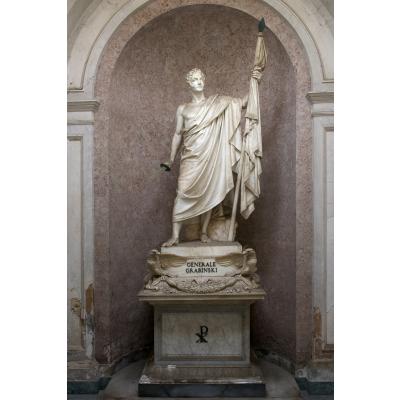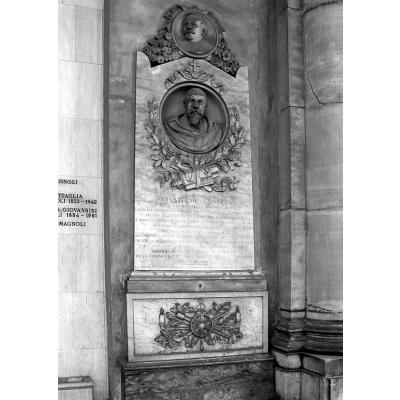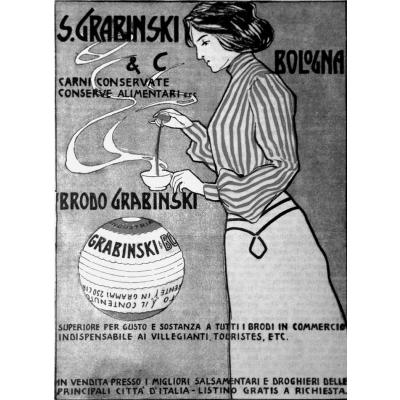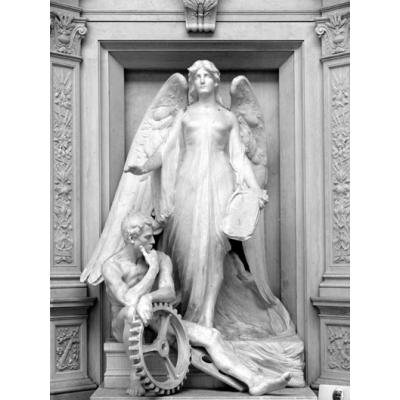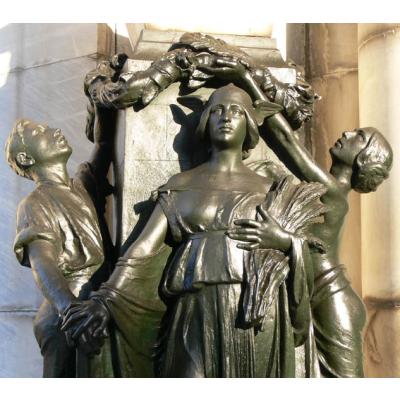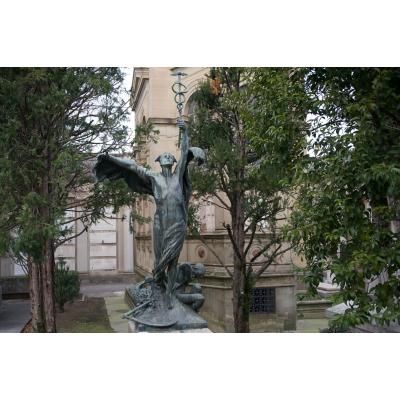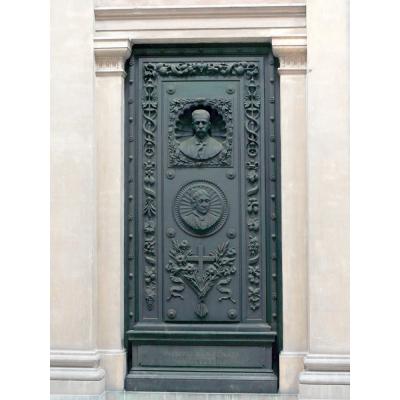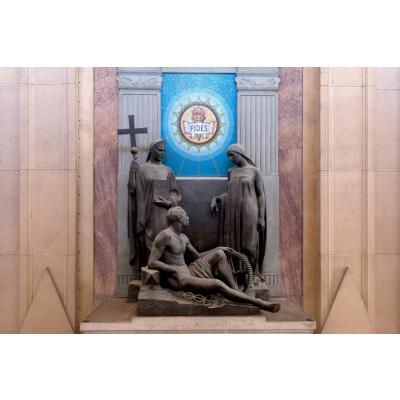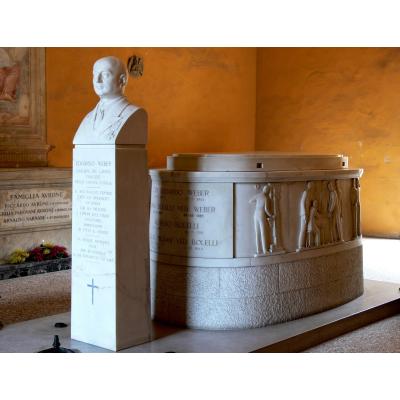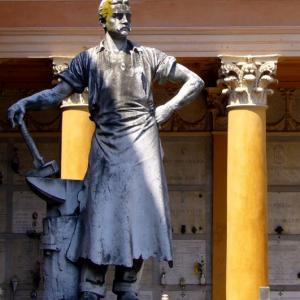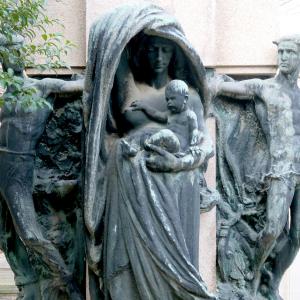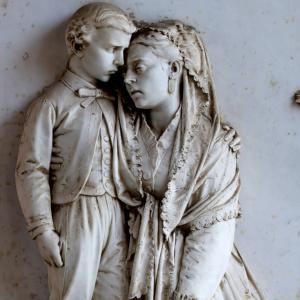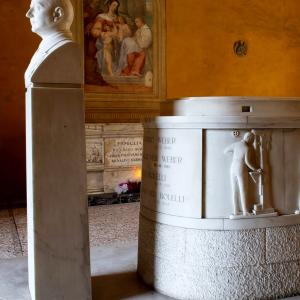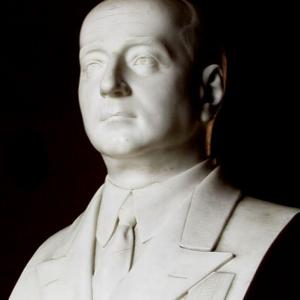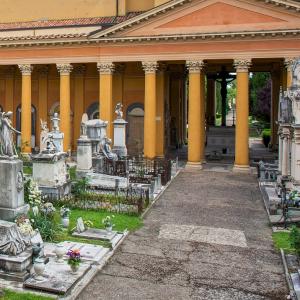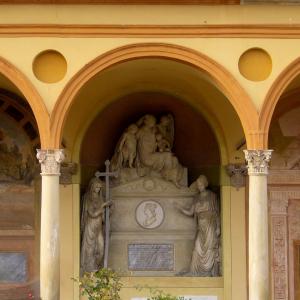Schede
A stroll in the Certosa cemetery allows visitors to retrace the history of the last two centuries and thereby understand the economic events that led from an agricultural context to that of modern mechanical industry. In the middle of the 19th century Bologna was in the midst of an economic crisis that saw the closure of textile factories, such as Filippo Manservisi's wool yarns and fabrics. In the cemetery the relatives of the entrepreneur had the following sentence engraved on the tomb: "distinguished in the art of weaving and mechanics practiced for 20 years, in the factory that was named after him and that rose to the pride and decorum of Bologna, destroyed by hard and adverse events".
In this difficult period the economy was developed by the small and middle class together with some noble families. Exemplary in this sense is the case of the Pizzardi family who, thanks to the skilful economic management of the land acquired at the beginning of the nineteenth century, accumulated enormous wealth. In Certosa, the tombs of the Pizzardi and Grabinski families are located opposite each other, both embellished with marble masterpieces. The family of Polish origin wished to remember Giuseppe, the Napoleonic general who had contributed to the uprisings of 1831; there is no mention of the agricultural activities or those related to the "Grabinski stock cube" produced by his nephew Stanislao. The Pizzardi commissioned a colossal marble deity from the sculptor Cincinnato Baruzzi. The female figure is intended to represent the concept of industry, with a rare combination of classical symbols that are meant to refer to the shrewdness of administration and the prosperity achieved through agricultural activities. In Certosa it is not difficult to identify the small productive bourgeoisie, as the millenary symbols linked to these activities, the caduceus (commerce), the anchor (hope) and the cornucopia (abundance) are regularly found in the small tombs built between the 1830s and 1860s (click here to introduction at funerary symbols). Among the monuments of this period, we highlight the Calzoni stele, dedicated to the founding family of the oldest local mechanical industry, which later specialised in the production of agricultural machinery, engines and turbines. Another example worth mentioning is the monument dedicated to Nicola Zanichelli, founder of the publishing house of the same name. At the base of the arch there are several books and the coat of arms in which the harvester appears, associated by the company with the motto "Laboravi fidenter" ("I worked with trust"). To find a convincing representation of industry we have to wait until the end of the century in Europe, when big and heavy cogwheels appear alongside strong and robust men. Pasquale Rizzoli is called to sculpt some representations of this kind. To his chisel we owe the Allegory of Fire for the manufacturer of matches Gaspare Pizzoli, or for the brewer Camillo Ronzani, for whom he creates a powerful and severe Allegory of Industry. The grandiose Benfenati stele is to be understood interpreting the present classical symbolism that allocates the commercial virtues that brought Filippo Benfenati some fame with the production of buttons and badges, but above all with his machine for cold welding of food metal boxes. At the same time, the intellectual environment also turned its attention to science and practical application. We highlight the stele dedicated to Sebastiano Zavaglia who, as the epigraph on the tomb states "he taught natural sciences in the technical school, was a skilled mechanic and Director of the Aldini Cabinet, and owes his fame to his writings and works of the highest quality to the ingenious balance barometer he constructed using a new technique”.
The real economic development of the city took place only with the construction of the railway line and above all with the accession to the Savoy State in 1860. In the years between the two centuries the cemetery also became a mirror of these rapid social and economic changes, and to the monuments of classical taste were added memorials where the emerging bourgeoisie exalted its image, portraying itself with the clothes used daily and surrounded by symbols that clearly refer to practical activities and not to intellectual ones. The portrait of the blacksmith Gaetano Simoli, immortalised by the sculptor Tullo Golfarelli in his work clothes and at the height of his physical strength, assumes great significance. He expresses the pride of the working class, becoming a symbol that goes beyond a mere artistic concept, so much so that Giovanni Pascoli describes him as "a handsome young blacksmith, one hand on his hip, the other on the hammer resting on the anvil: proud, haughty, severe, serene". One can be proud of one's humble condition, since what elevates a person is his dignity and his contribution to progress, so much so that the expression "work ennobles man" finds here a convincing representation. Since the beginning of the twentieth century, marble and bronze works appear more and more often, exalting, among true images and allegories, the economic activities of the deceased. Worthy of note are the monuments dedicated to the baker and pasta producer Paolo Atti and to Clodoveo Franchini, the last representative of a family of watchmakers, mechanics and scientific equipment manufacturers. The development of the mechanical sector in the first twenty years of the twentieth century took on considerable dimensions in the city, and it is not by chance that after the 1930s significant monuments were constructed in the cemetery to commemorate the founders of many companies that still operate in Bologna today. We would like to recall some of them here. The Ricciotti Paioli arch, where the founder of the company producing shock absorbers and suspensions for motorbikes rests. The Barbieri cell, where Gaetano, founder of A.C.M.A., rests (automatic machines). The Pizzirani cell is adorned with a beautiful allegory of industry, and in fact the cavaliere di lavoro Carlo, one of the founders of Curtisa, specialized in the production of metal frames, rests there. Immediately after the death of Alfieri Maserati, the sculptor Mario Sarto was called upon to make the memorial stone that is meant to recall the "pioneer of motor and speed". The artist extolled the industrialist and the sportsman, both with a plaque that repeated the now customary theme of the hammer on the anvil, and with the nineteenth-century symbol of eternity - the wings and the Ouroboros snake - updated here with a novel winged steering wheel, never to be repeated again.
At the end of the Fascist regime, sculptors were invited to exalt the equal dignity of owner and worker, showing the high social and moral value of the work. An absolute masterpiece of twentieth-century Bolognese art is the monument dedicated to Edoardo Weber, sculpted by Venanzio Baccilieri: here designers and workers are represented side by side as they discuss and oversee the various production phases of the famous carburetor. With the same spirit, Baccilieri also executed the frieze dedicated to Torquato Vegetti, founder of the 'Torvegg'. Another example of this spirit is the one made by Romano Franchi for the printer Giuseppe Capi, to which is added an unusual female working presence, very rare to find in any Italian cemetery. It is not by chance that the sculptor himself executed a beautiful bas-relief dedicated to Giuseppe Minganti and his wife Gilberta Gabrielli: in the centre is a portrait of Giuseppe, one of the pioneers in the production of machine tools, surrounded by his workers with whom he converses serenely, surrounded by industrial equipment. Only the epigraph recalls his wife, the first female cavaliere di lavoro of Italy. Pleasant but more usual - we would say 'cemeterial' - are the monuments created in this period for the families Carpigiani (ice cream machines), Cattabriga (ice cream machines), Preci (automatic machines), Morini (motorbikes), Morara (machine tools). Out of the common register is the Ducati family's small crypt for ashes. The simple monolith seems to indicate nothing about the industrial activity. Visitors to the Certosa should not miss the small frame at the base, where the epigraph sounds like a moral warning still valid today: "honesty and constant work are the family coat of arms, as they always were".
Reference bibliography: La Ruota e l’Incudine la memoria dell’Industria Meccanica bolognese in Certosa, Minerva, 2016.




